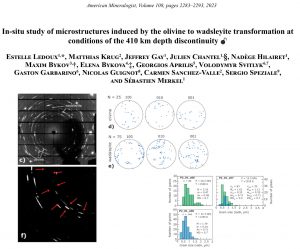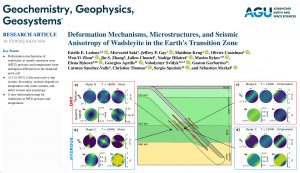 Former TIMEleSS post-doc John Keith Magali has a new publication: Pressure-dependent large-scale seismic anisotropy induced by non-Newtonian mantle flow. The work was published in May 2024 in Geophysical Journal International.
Former TIMEleSS post-doc John Keith Magali has a new publication: Pressure-dependent large-scale seismic anisotropy induced by non-Newtonian mantle flow. The work was published in May 2024 in Geophysical Journal International.
In this work, John combines the team expertise in both mineral microstructures and seismic measurements to make predictions of seismic anisotropy development induced by mantle flow. In fact, observations of large-scale seismic anisotropy can be used as a marker for past and current deformation in the Earth’s mantle. Nonetheless, global features such as the decrease of the strength of anisotropy between ∼150 and 410 km in the upper mantle and weaker anisotropy observations in the transition zone remain ill-understood.
In this work, we integrate pressure-dependent microscopic flow properties in mantle minerals particularly olivine and wadsleyite into geodynamic simulations, compute the crystallographic preferred orientation and anisotropy in the upper mantle and upper transition zone, and apply a tomographic filter that accounts for finite-frequency seismic data, with the aim of providing mantle models comparable with seismic tomography observations.
Our results show that anisotropy observations in the upper mantle can be well understood by introducing gradual shifts in strain accommodation mechanism with increasing depths induced by a pressure-dependent plasticity model in olivine. Across the upper transition zone, our models predict reasonably low anisotropy, in agreement with observations.
These calculations show that, despite the relatively primitive geodynamic setup, models of plate-driven corner flows can be sufficient in explaining first-order observations of mantle seismic anisotropy. This requires, however, incorporating the effect of pressure on mineralogy and mineral plasticity models.










 The TIMEleSS team has a new publication! In the December 2023 issue of American Mineralogist, former TIMEleSS student Estelle Ledoux present an
The TIMEleSS team has a new publication! In the December 2023 issue of American Mineralogist, former TIMEleSS student Estelle Ledoux present an 
 Time to meet again! On Friday Oct 28th, 2022, TIMEleSS members met to discuss anisotropy in the upper mantle and transition zone.
Time to meet again! On Friday Oct 28th, 2022, TIMEleSS members met to discuss anisotropy in the upper mantle and transition zone.